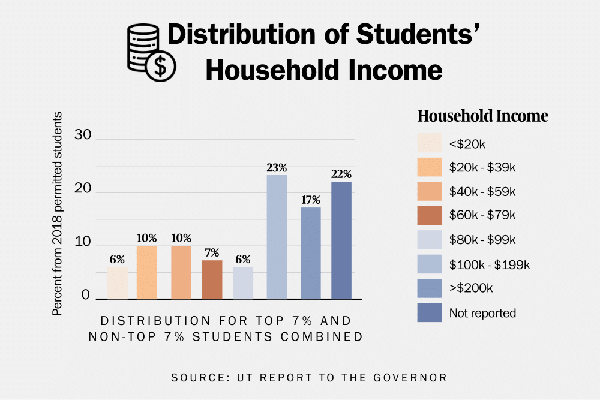In recent years, reports show UT students have primarily come from wealthy families.
According to the UT Report to the Governor, more than 50% of reported family incomes of UT students enrolled in 2018 were greater than the national median income of $61,372, cited by the U.S. Census Bureau. The New York Times reported in 2017 the median family income for a UT student was $123,900.
Affluent families have more choices in the schools their children attend, influencing access to Advanced Placement classes and extracurricular activities, Plan II lecturer Jill Kolasinski said. Additionally, their children are more likely to take the SAT or ACT multiple times and have time to volunteer, said Kolasinski, who founded a charter school network called KIPP Austin Public Schools.
“Even a seemingly income-neutral criterion like class rank (which determines automatic admissions) is going to be impacted by things such as having access to enrichment activities, like tutoring, greater access to resources like computers and high-speed internet, test prep (and) travel,” said Richard Reddick, educational
leadership and policy associate professor.
A holistic admissions process is used to determine the specific college auto-admit students are admitted to and whether non auto-admit students are admitted to UT. In addition to coursework and grades, this process considers special circumstances such as socioeconomic status and adversity, said Kendall Slagle, communications coordinator for the Office of the Executive Vice President and Provost. UT receives more applications from students of family income brackets exceeding $80,000, which could partially explain the distribution of household incomes of UT students, Slagle said.
“(Students admitted holistically) talk about the challenges they may have faced on their pathway to college,” Reddick said. “But even knowing how to talk about your experience without sounding like you’re apologizing for your circumstances is a skill, and many college counselors in underresourced (schools) don’t have the bandwidth to give all students the support … to shape their application.”
Laura Nguyen, a management information systems sophomore, said until her senior year of high school, she didn’t know what colleges sought in applicants.
“When I was starting out as a (high school) freshman, I had no idea what GPA was,” Nguyen said. “A lot of the kids in the top 10% (of the class) took SAT classes outside of school. They were able to afford it. They also had parents who actually went to college, so they had somebody to guide them, or they had a network community that would help them with the process. I felt like I had to work twice as hard.”
Even when students from low-income backgrounds are admitted to UT, they face other barriers to accepting their offers, such as the high cost of living in Austin, Reddick said. For those who overcome these barriers, however, institutions like UT can push students’ learning and extend their connections to later receive a job, start a business or pursue other post-college endeavors, Reddick said.
“These effects are most powerful for students from underrepresented backgrounds,” Reddick said. “College is giving them access to these networks that they can’t get another way, like being from a wealthy neighborhood or having parents with extensive networks. Attending UT can be a ‘generation changer’ for a low-income student or a student of color.”





















